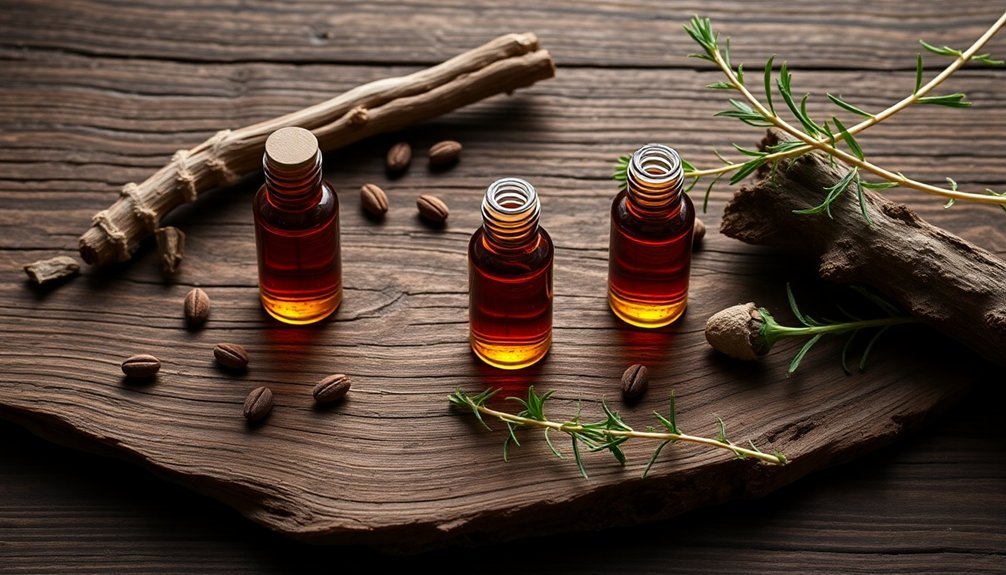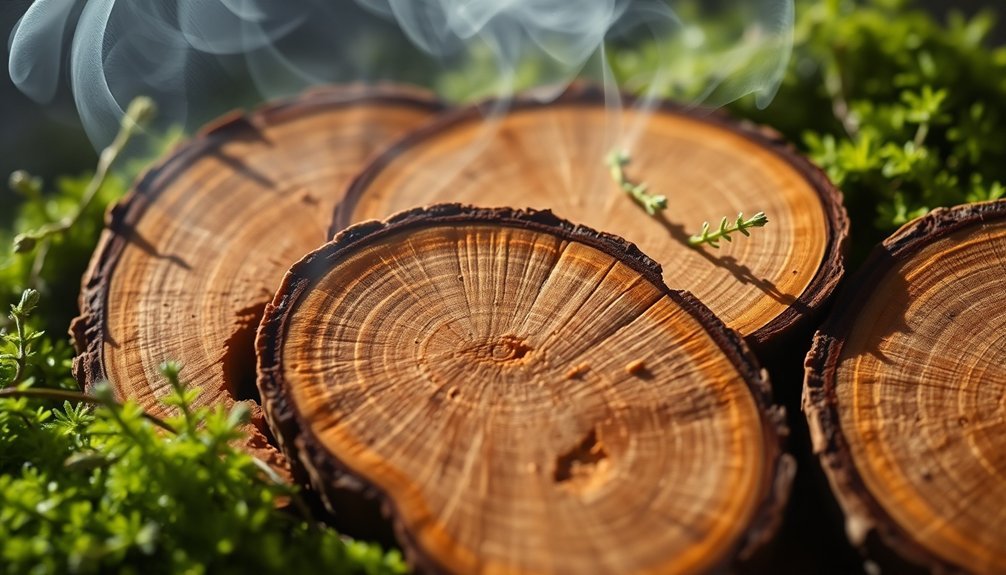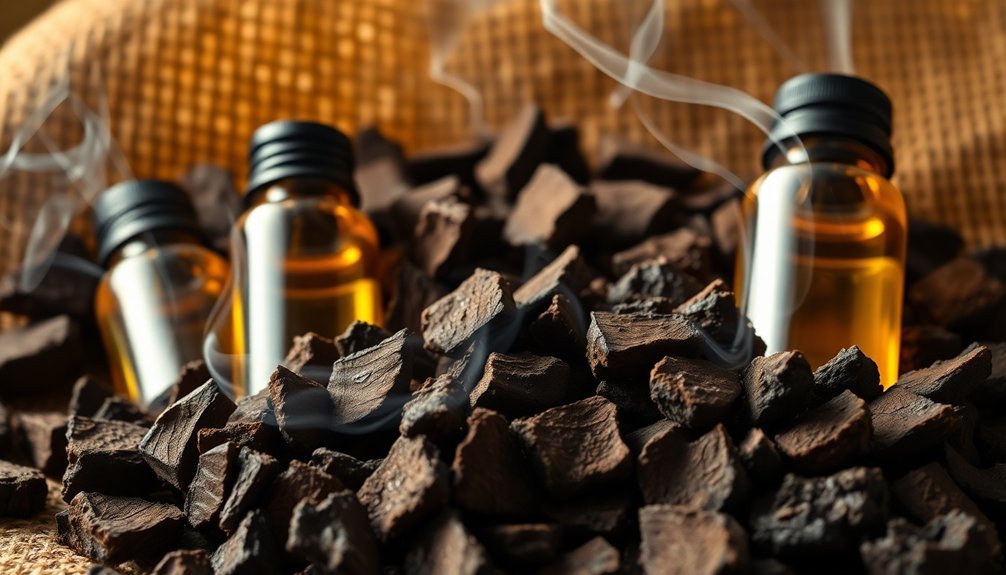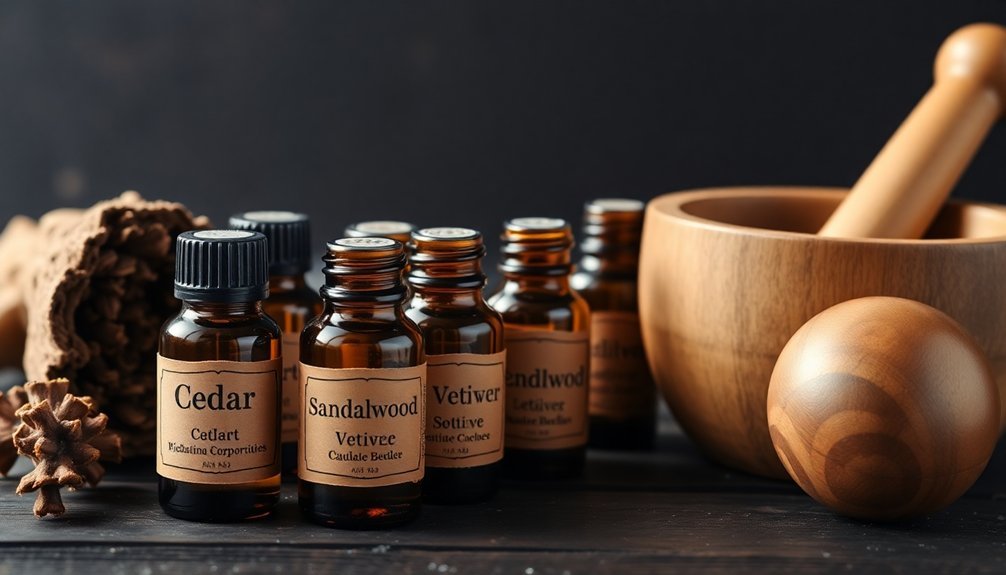Base notes form the vital foundation of woody perfumes, with sandalwood, cedarwood, and oud serving as essential anchors. You'll want to follow the 30/50/20 blending rule, dedicating 20% to these deep, lasting notes. Start with sandalwood for its versatile blending capabilities, then experiment with different cedarwood varieties for unique characteristics. Combine with natural fixatives like benzoin or myrrh to enhance longevity. Understanding these woody foundations will unleash endless aromatic possibilities.
Understanding the Role of Base Notes in Woody Perfumes

While many fragrance elements come and go, woody base notes form the foundation of long-lasting perfumes. You'll find these enduring components working tirelessly beneath the surface, anchoring your fragrance's more volatile notes and ensuring they develop beautifully over time.
When you're exploring woody base notes, you'll encounter distinct categories that each bring unique characteristics to your blend. The inclusion of sandalwood and oud creates a luxurious complexity that elevates any fragrance composition.
Dry woods like cedarwood and vetiver add an earthy elegance, while mossy woods create rich, damp undertones.
Resinous varieties such as frankincense and myrrh deliver balsamic sweetness with hints of spice.
What's remarkable about these base notes is their versatility – they'll enhance everything from florals to orientals, adding sophistication and depth while extending the life of your fragrance considerably.
Classic Sandalwood: The Foundation of Woody Blends
You'll find sandalwood's natural creamy texture creates an irresistible foundation in woody perfumes, offering both warmth and sophistication to any blend.
Its sacred origins in ancient cultural traditions have elevated it to legendary status among perfumers who prize its rich, lasting presence.
You can explore sandalwood's versatile nature through its harmonious partnerships with florals, spices, and citrus notes, making it an essential building block in contemporary perfumery. The finest examples like Eau de parfum 301 showcase its appeal through warm and cold spices, creating a mesmerizing olfactory experience.
Natural Creamy Texture Profile
At the heart of woody perfumes lies sandalwood's distinctive creamy profile, setting it apart from other wood-based fragrances.
You'll notice its buttery, milky undertones create a smooth, luxurious texture that feels both comforting and sophisticated. Unlike sharper woody notes, sandalwood's sweet balsamic qualities add a natural depth that embraces your senses. The essential oil extracted from the Indian sandalwood heartwood gives this cherished ingredient its unmistakable aroma.
When you're exploring sandalwood-based perfumes, you'll discover how this creamy character enhances other fragrance notes.
It's particularly striking when combined with florals like gardenia or jasmine, where it adds a rich, velvety foundation. The creamy texture also pairs beautifully with vanilla and amber, creating warm, sensual compositions that feel incredibly natural.
This versatile base note's ability to complement without overwhelming makes it essential in crafting balanced, sophisticated woody blends.
Sacred Historical Origins
Beyond its luxurious creamy profile, sandalwood carries a rich heritage stretching back thousands of years to ancient India.
You'll find its sacred roots deeply embedded in religious ceremonies, where it served as a symbol of purity and divine connection. As ancient trade routes expanded, this precious wood traveled from Indian temples to Egyptian pharaohs' tombs and Chinese imperial courts, becoming a treasured luxury across civilizations.
- Used in sacred Indian meditation practices and religious rituals
- Incorporated into Egyptian embalming ceremonies alongside gold
- Prized in Imperial China as a symbol of refinement and prosperity
- Transformed into exquisite incense blends across the Middle East
- Found in temple ceremonies throughout Southeast Asia
This revered ingredient's journey from ancient spiritual traditions to modern perfumery showcases its enduring allure and cultural significance.
Versatile Blending Capabilities
When exploring woody perfumes, sandalwood stands as a masterful foundation due to its remarkable versatility in blending.
You'll find it pairs beautifully with citrus notes like bergamot and grapefruit, creating fresh, invigorating daytime fragrances perfect for summer wear.
If you're seeking elegance, sandalwood's combination with florals like jasmine and rose produces sophisticated, romantic scents ideal for formal occasions.
For winter fragrances, you can blend it with spices such as cinnamon and cardamom to achieve warm, mysterious aromas suited for evening wear.
You'll discover its most complex expressions when combined with other woody notes like cedar and vetiver, or when paired with amber for luxurious depth.
The addition of frankincense and myrrh creates timeless, harmonious perfumes that showcase sandalwood's full character.
Exploring Different Types of Cedarwood Notes

The diverse world of cedarwood encompasses several distinct varieties, each offering unique aromatic profiles that perfumers prize.
You'll discover that Atlas Cedarwood from Morocco brings warm, woody sweetness, while Virginian Cedarwood delivers a sharper, herbal character.
When you're exploring these notes, you'll notice how Texas Cedarwood stands out with its spicy punch, and Siberian Cedarwood captivates with its resinous depth.
- Atlas Cedarwood works beautifully in sweet, oriental blends
- Virginian Cedarwood adds fresh, green dimensions to fragrances
- Texas Cedarwood brings unexpected spicy warmth to compositions
- Siberian Cedarwood contributes deep, balsamic undertones
- Each variety creates unique base notes that last for hours
These different cedarwood types let you craft distinctive woody fragrances, from light and fresh to deep and complex.
Patchouli and Vetiver: Earthy Anchors for Woody Compositions
Among nature's most potent grounding elements, patchouli and vetiver stand as essential pillars in woody perfume compositions.
While patchouli offers an earthy aroma reminiscent of forest floors, vetiver contributes its distinctive rooty character with caramel undertones.
You'll find these ingredients work exceptionally well together, creating a deeply calming and sensual blend that's perfect for relaxation.
They're particularly effective when you're looking to reduce anxiety or stress through aromatherapy.
When you combine them with complementary notes like sandalwood or frankincense, you'll achieve an even richer woody profile.
Whether you're crafting solid perfumes, sprays, or candles, this versatile duo adds substantial weight to your base notes while maintaining their natural, sustainable appeal.
Their earthy qualities make them indispensable anchors in any woody composition.
Oud and Its Complex Aromatic Profile

Moving beyond traditional woody bases, oud represents one of perfumery's most fascinating ingredients.
You'll find this complex aromatic treasure offering a deep, woody foundation enriched with smoky undertones and subtle animalic nuances. Its versatility in luxury fragrances stems from its remarkable chemical composition of terpenes, phenols, and unique aromatic compounds.
- Pure oud oil contains the highest concentration of aromatic compounds, making it especially prized
- Different varieties like woody, spicy, and floral oud let you customize your fragrance experience
- It blends seamlessly with both light florals and rich spices
- The scent profile changes with each type, from deep and earthy to sweet and exotic
- You can wear oud-based fragrances year-round, with spicier blends perfect for winter and lighter compositions ideal for summer
Natural vs. Synthetic Woody Base Notes
Perfumers face a critical choice between natural and synthetic woody base notes when crafting signature fragrances. Natural options like sandalwood and cedarwood provide authentic, complex aromas with sophisticated depth, while synthetic alternatives offer consistency and cost-effectiveness.
| Aspect | Natural Woody Notes | Synthetic Woody Notes |
|---|---|---|
| Aroma | Complex, authentic | Simplified, uniform |
| Cost | Higher, variable | Lower, stable |
| Longevity | Variable but deep | Consistent |
| Blending | Versatile, natural | Requires expertise |
| Consumer Appeal | Luxury, premium | Mass-market friendly |
You'll find that natural woody notes bring unmatched richness and character to fragrances, evoking forests and nature. However, if you're working with budget constraints, synthetic alternatives can still deliver reliable woody profiles. Your choice ultimately depends on your project's goals, whether you're prioritizing authenticity or consistency in your fragrance creation.
Proper Ratios for Woody Base Note Combinations

When crafting woody perfume blends, mastering the right ratios of base notes is essential for achieving a balanced and lasting fragrance.
You'll want to follow the 30/50/20 rule as your starting point, dedicating 20% of your blend to base notes. For a 10-drop blend, this means using 2 drops of woody base notes like sandalwood, cedarwood, or vetiver.
- Combine different woody notes (like sandalwood and cedarwood) by splitting the 20% base note allocation between them.
- Start with a stronger woody note at 15% and complement it with a lighter one at 5%.
- Adjust ratios based on each oil's intensity and your desired outcome.
- Consider how base notes interact with middle notes for ideal blending.
- Test small batches first, as woody notes can be powerful and long-lasting.
Enhancing Longevity With Complementary Fixatives
Beyond mastering base note ratios, the strategic use of fixatives can dramatically extend your woody perfume's longevity.
You'll find both natural and synthetic options to enhance your blend's staying power. Natural fixatives like benzoin, myrrh, and sandalwood not only stabilize your fragrance but also add rich, authentic depth.
For a more consistent result, you can incorporate synthetic fixatives like Iso E Super or Ambroxane.
To maximize effectiveness, apply your fixative-enhanced perfume to well-moisturized skin.
You'll notice how these ingredients slow down the evaporation of your fragrance oils while maintaining the balance between notes.
They're particularly effective when combined with woody elements like cedar and patchouli, ensuring your scent remains balanced and noticeable throughout its wear time.
Blending Techniques for Balanced Woody Foundations

You'll want to start by carefully layering your wood notes in a deliberate sequence, beginning with lighter woods like cedar before introducing denser ones such as sandalwood or oud.
When combining essential oils, follow the 30-30-40 ratio rule where your primary wood note takes 40% while supporting woods each contribute 30% to create a balanced foundation.
To achieve harmony between woods and resins, incorporate small amounts of complementary resins like frankincense or myrrh to enhance the woody character without overwhelming it.
Layering Woods With Purpose
Creating balanced woody foundations requires a thoughtful approach to layering different wood varieties and their complementary notes.
You'll want to start with dry woods like cedarwood or vetiver as your base, then build complexity by adding resinous elements such as frankincense or myrrh.
Consider the seasonal impact of your choices, using lighter woods for summer and richer notes like oud for winter compositions.
- Start with sandalwood for a creamy, versatile foundation that plays well with other notes
- Layer in patchouli to add earthy depth and enhance longevity
- Incorporate mossy woods for a damp, rich undertone
- Add citrus or floral elements to brighten the composition
- Use fixatives like benzoin to anchor your blend while maintaining its character
Essential Oil Ratio Rules
When formulating woody perfumes, mastering essential oil ratios forms the cornerstone of a successful blend.
You'll want to follow the 20% concentration rule, which means using 20 drops of essential oils for every 80 drops of carrier oil in a 5ml rollerball bottle. If you have sensitive skin, reduce this to 15%.
For your essential oil blend, follow the 30/50/20 rule: dedicate 30% to top notes, 50% to middle notes, and 20% to base notes.
In a 20-drop blend, this translates to 6 drops of top notes, 10 drops of middle notes, and 4 drops of base notes.
Remember to use separate pipettes for each oil type to maintain purity. Start with small amounts and adjust gradually until you achieve your desired woody fragrance profile.
Harmonizing Resins and Woods
To achieve a harmonious woody foundation, start by selecting complementary wood and resin notes that align with your desired fragrance profile.
You'll find that resinous notes like Frankincense and Myrrh naturally enhance the depth of woody bases while adding complexity to your blend. When combining these elements, add your modifiers drop by drop to maintain balance and create a sophisticated finish.
- Use Cedar Atlas or Sandalwood as your primary woody base
- Layer Frankincense or Myrrh to add rich, resinous depth
- Incorporate fresh citrus notes to brighten the composition
- Add spicy elements like Black Pepper for warmth
- Finish with fixatives such as Vanilla or Tonka Bean to extend longevity
Remember to test your blend at each stage, as both woods and resins are potent materials that can quickly overwhelm a composition if not properly balanced.
Frequently Asked Questions
How Does Altitude Affect the Harvesting of Woody Materials for Perfumery?
You'll find that altitude primarily affects harvesting through increased transportation costs and logistical challenges. While it doesn't markedly impact wood quality, higher elevations can make accessing and moving woody materials more difficult and expensive.
Can Woody Base Notes Trigger Allergic Reactions in Sensitive Individuals?
Yes, you can experience allergic reactions to woody base notes. They're known to trigger contact dermatitis, skin irritation, and rashes. If you're sensitive, you should patch test before using woody fragrances.
Which Woody Notes Work Best in Tropical Versus Cold Climates?
In tropical climates, you'll want lighter woods like vetiver and oud for their fresh, airy qualities. For cold climates, opt for richer woods like cedarwood and warm sandalwood to create cozier, more enveloping scents.
Do Woody Base Notes Interact Differently With Different Skin Ph Levels?
Yes, your skin's pH level greatly affects woody base notes. If you've got acidic skin, they'll smell sharper but fade faster. On alkaline skin, you'll notice warmer, longer-lasting woody notes with richer character.
How Do Moonlight and Harvest Timing Affect Woody Note Intensity?
While moonlight doesn't chemically affect woody notes, harvest timing does impact their intensity. You'll find that ingredients harvested at peak maturity during ideal seasonal conditions produce stronger, more vibrant woody fragrances in perfumes.
In Summary
When you're creating woody perfume blends, you'll find that mastering base notes is essential for a successful fragrance. Remember to balance your natural and synthetic woods carefully, maintain proper ratios, and always include reliable fixatives. Don't forget that classic ingredients like sandalwood, cedarwood, and oud can work together or shine individually. With practice, you'll develop an intuitive sense for crafting lasting woody foundations.





Leave a Reply